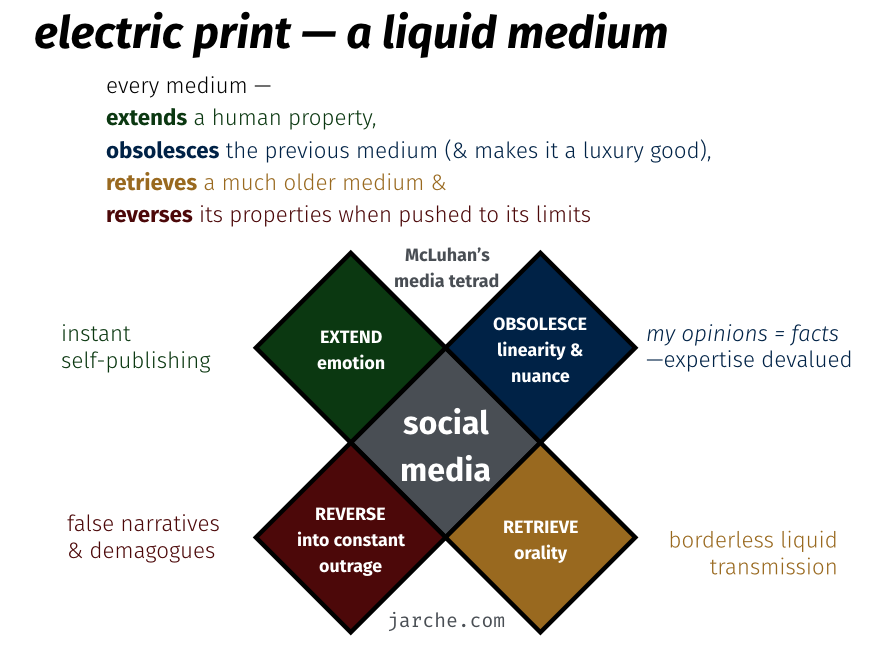turmoil and experimentation
Author: Harold Jarche
Go to Source
Renee DiResta discusses the challenges brought about by the printing press — invented in Europe in 1450 — and compares these with the current effects of digital networks in — Mediating Consent.
The printing press, invented approximately 50 years before the 95 Theses, extended Luther’s reach from the door of the cathedral to the entirety of Europe. His criticisms of the Church were the first use of mass media: critiques of Catholic doctrine in pithy, irreverent pamphlets, produced at scale and widely distributed. As a result, Luther ushered in not only Protestantism, but an entirely new media landscape: one in which traditional gatekeepers — the church, wealthy nobles — no longer held a monopoly on the information that reached the people. The Catholic Church responded, of course, with pamphlets of its own — defending Catholic doctrine, refuting the new heretics, fighting the battle for hearts, minds, and Truth. —RibbonFarm

Today, we face similar challenges in dealing with a new technology that challenges the status quo. Social media are liquid print which easily seep into society, transcend boundaries, and bypass gatekeepers.
The vast majority of the posts within online factional communities reinforce in-group identity and beliefs. Even in the most highly manipulative — say, those created by the Internet Research Agency — the goal was primarily to entrench people in their view of the world. Through that entrenchment, however, it becomes possible to increase the divide between groups. The high degree of trust and consensus within a community stands in stark contrast to the extent of expressed distrust (often, disgust) for members of other factions, their media sources, and their authorities, institutions, and facts. We’ve entered an era of conflicting pseudo-realities, a sort of Archipelago of Dissensus. No institutional or media entity retains sufficient moral authority, legitimacy, or the degree of trust required to link the islands, to mediate conflicting narratives or resolve debates about facts. —RibbonFarm

DiResta concludes that all is not lost.
Each successive major information revolution has delivered a period of turmoil, much like today’s … Ultimately, the promise of social media — systems to facilitate human connection, and to disintermediate access to information – still has the potential to be a powerful force for good in the world. But it won’t happen on its own. The future that realizes this promise still remains to be invented. —RibbonFarm
What we can conclude by comparing the advent of print with electric/digital communications is that there will be a resulting significant shift in how we organize as a society. As we become a network society, we could develop into a state of metamodernity, a society not run by tribes, institutions, or markets. This is the optimistic perspective.

There are several variations of what metamodernity will look like, as analysed by the engineering group Arup in — 2050 Futures: Four Plausible Scenarios.
POST ANTHROPOCENE shows how societal conditions and planetary health might exist in a harmonious relationship, fortifying each other for mutual progress and benefit. Taman, a biotech project manager in Jakarta, is finding his place in this balanced world.
GREENTOCRACY describes an improvement in planetary health which has been enabled by severe restrictions on human society: restrictive living conditions, conflict and authoritarian regimes prevail. The accompanying story details the everyday compromises made by Moussa as he heads to work in eastern Senegal.
EXTINCTION EXPRESS depicts both declining planetary health and societal conditions. It is questionable how much longer humanity can survive. Caitlyn, an Oslo-based commodities trader, is shocked into facing the realities of her privileged existence.
HUMANS INC. represents our current trajectory; a world in which societal conditions advance at the cost of planetary health. The accompanying story describes Yuka, a Nunavut native, as she struggles with the changes that have engulfed her once remote home.
The Post-Anthropocene scenario is one of both improved societal conditions and planetary health. It requires 97% clean energy in order to result in only a 1.3°C global temperature increase. It is the one I hope will be the future for our children.
So will the metamodern era evolve into the post-anthropocene scenario? As I responded in the comments to the first article, it depends on us — now. It was almost 300 years from Gutenberg’s invention of the European printing press (1450) until the Age of Enlightenment beginning in 1715. If we see digital media — first invented as telegraph transmissions in 1855 — to be the dawn of the electric/network age, then we may have a similarly long period of turmoil still ahead of us. It takes a long time for all generations to forget how things used to be. In the meantime, I think the best approach for our current, mixed-up, society is to keep experimenting with new organizational and governance models. It can be our legacy to future generations living in a network society.
